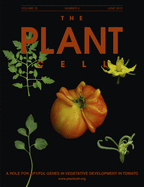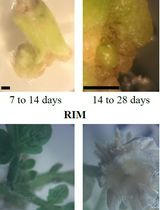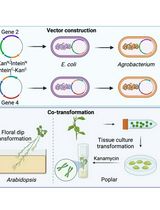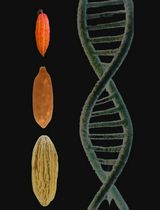- EN - English
- CN - 中文
Measuring Homologous Recombination Frequency in Arabidopsis Seedlings
拟南芥幼苗中同源重组频率的测定
发布: 2014年04月05日第4卷第7期 DOI: 10.21769/BioProtoc.1094 浏览次数: 13224
评审: Masahiro MoritaRu ZhangAnonymous reviewer(s)
Abstract
Somatic homologous recombination (SHR) is a major pathway of DNA double-strand break (DSB) repair, in which intact homologous regions are used as a template for the removal of lesions. Its frequency in plants is generally low, as most DSB are removed by non-homologous mechanisms in higher eukaryotes. Nevertheless, SHR frequency has been shown to increase in response to various chemical and physical agents that cause DNA damage and/or alter genome stability (reviewed in March-Díaz and Reyes, 2009). We monitor the frequency of SHR in transgenic Arabidopsis seedlings containing recombination substrates with two truncated but overlapping parts of the β-glucuronidase (GUS) reporter gene (Orel et al., 2003; Schuermann et al., 2005). Upon an SHR event, a functional version of the transgene can be restored (Figure 1A). A histochemical assay applicable to whole plantlets allows the visualization of cells in which the reporter is restored, as the encoded enzyme converts a colorless substrate into a blue compound. This type of reporter has been extensively used to identify gene products required for regulating SHR levels in plants. We analyze plants stimulated for SHR by treatments with DNA damaging agents (bleocin, mitomycin C and UV-C) and compare them to non-treated plants.
Keywords: Homologous recombination (同源重组)Materials and Reagents
- Arabidopsis thaliana seeds of reporter lines IU.GUS-8 and DGU.US-1 (Figure 1) (Orel et al., 2003) [introgressed into various genetic backgrounds and genotyped for homozygosity of reporters and mutations (Rosa et al., 2013). As an example, we use wild type Columbia-0, and mutants arp6-3 and swc6-1. Both mutants lack subunits of the Arabidopsis homolog of the SWR1 complex and, additional to being sensitive to DNA damaging agents (Rosa et al., 2013), have pleiotropic developmental defects (for more information see Schuermann et al., 2005)]
- Sodium hypochlorite (Sigma-Aldrich, catalog number: 425044 )
- Tween-80 (Sigma-Aldrich, catalog number: 4780 )
- Sterile H2O
- Solid growth medium
- Liquid plant growth medium (same as solid growth medium but without agar)
- Hydroxyurea
- 70% ethanol
- Seed sterilization solution (see Recipes)
- Bleocin (commercial name for bleomycin) (EMD Millipore, catalog number: 203408 ) (see Recipes)
- Mitomycin C (Duchefa Biochemie BV, catalog number: M0133 ) (see Recipes)
- GUS staining solution (see Recipes)
- 1 M Sodium Phosphate Buffer (see Recipes)
Equipment
- Plastic petri dishes for plant culture (see Notes) (round 200 x 15 mm, with 20 ml of solid growth medium)
- Sterile hood, preferably a biological safety cabinet to avoid exposure to the genotoxins
- Bench top block shaker (e.g. Eppendorf, Thermomixer®)
- UV crosslinker (254-nm UV light bulbs, 15 watts each) (Stratagene, model: Stratalinker 2400 )
- Forceps
- Box or aluminum foil
- Parafilm
- 1.5 ml Eppendorf tubes
- 50 and 15 ml Falcon tubes
- Vacuum applicator (e.g. desiccator)
- Plant growth facilities with 16-h-light/8-h-dark cycles, at 21 °C
- Incubator at 37 °C
- Stereomicroscope
Procedure
文章信息
版权信息
© 2014 The Authors; exclusive licensee Bio-protocol LLC.
如何引用
Rosa, M. and Scheid, O. M. (2014). Measuring Homologous Recombination Frequency in Arabidopsis Seedlings. Bio-protocol 4(7): e1094. DOI: 10.21769/BioProtoc.1094.
分类
植物科学 > 植物生理学 > 组织分析
植物科学 > 植物分子生物学 > DNA > DNA 重组
分子生物学 > DNA > DNA 重组
您对这篇实验方法有问题吗?
在此处发布您的问题,我们将邀请本文作者来回答。同时,我们会将您的问题发布到Bio-protocol Exchange,以便寻求社区成员的帮助。
Share
Bluesky
X
Copy link














